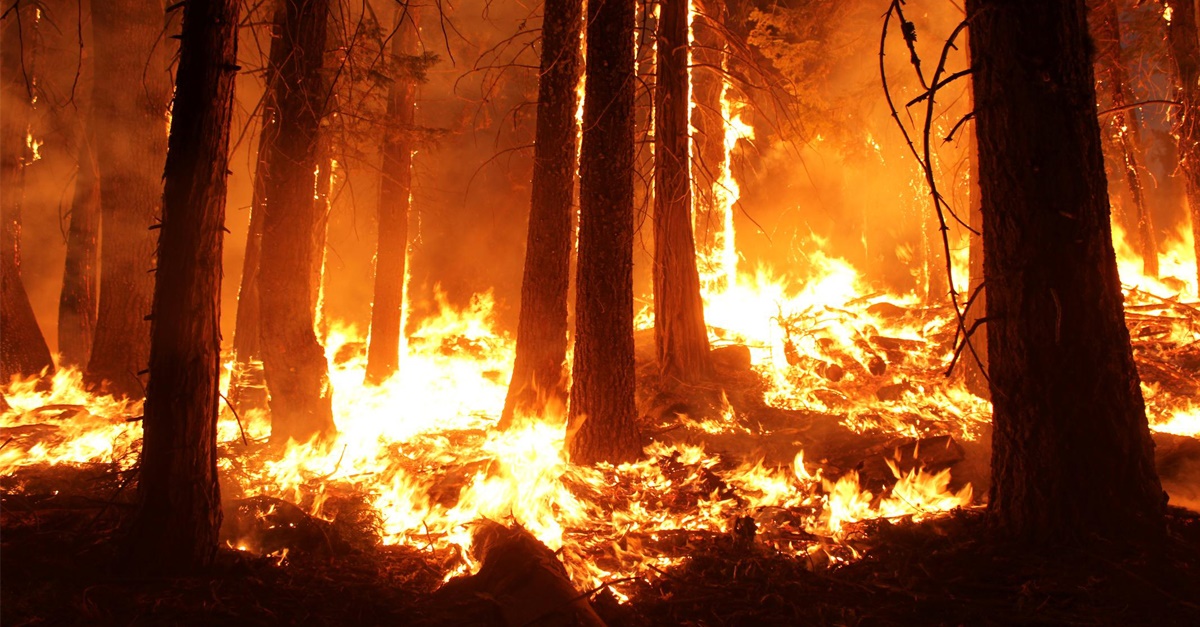The National Interagency Coordination Center reports that between 2018 and 2022, there were 295,483 wildfires that burned an astounding 38,257,018 acres nationwide.
Surprisingly, more wildfires occur in the eastern U.S. than in the western states. However, eastern fires are typically smaller than those in the west.
- In 2020, more than 33,000 fires burned approximately 700,000 acres in the east, while 26,000 wildfires burned approximately 9.5 million acres in western states.
- In 2022, 20,000 fires burned 5.8 million acres in the west compared to 48,000 fires only burned 1.8 million acres in the east.
Regional Growth into WUI Contributes to Increased Risk
A national assessment of wildfire risk in the United States indicates that California (50.22% risk) and the southern region of the country, encompassing the area from eastern Texas to the east coast and north to Kentucky and Virginia, (15.53% risk), are the geographic areas with the highest wildfire risk.
One of the contributing factors to this increased risk is the fact that the number of residential homes in the wildland/urban interface (WUI) has grown by about 350,000 homes per year. As of 2021, roughly 49 million homes were in these areas, increasing community risk for damage or injury caused by wildfire.
While the western areas of the U.S. are experiencing an expansion of development, it’s the south that is one of the fastest growing regions with 88 million acres classified as WUI. Because of the year-round fire season in this portion of the U.S., this region consistently has the highest number of wildfires per year and more than 50,000 communities are at high risk of wildfire damage.
Market Impacts
Wildfires can disrupt economic activity by destroying physical capital, interrupting transportation networks, impacting workers’ health, and decreasing tourism and recreation. In fact, of the nearly $150 billion in damages caused by California’s 2018 wildfires, approximately 60% were indirect economic losses caused by disruption to economic activity.
In 2020 alone, the estimated insurance and reinsurance market loss from wildfires that occurred largely in the western United States was $13 billion. The “economic” loss between 2017 and 2021 just for wildfire damage in California was $722 billion.
Reinsurers often pay the bulk of the losses after the insurer’s catastrophe reinsurance retentions are exhausted. As a result, reinsurance premiums have been increased and some reinsurers are requiring that admitted and non-admitted carriers reduce their aggregate exposures in wildfire areas or risk losing their reinsurance.
Insurers and reinsurers have an obligation to protect the solvency of their companies. To do this in the current environment, insurers must:
- Increase written premiums in low-hazard areas
- Decrease “wildfire exposures” in high hazard areas where aggregates (the total “Section I” limits of all in-force policies) are so high as to endanger solvency in the event of another wildfire
- Increase premiums in all geographic areas, particularly those where there is an increased risk of wildfire
- Discontinue writing products when they cannot get adequate premium increases to cover their expected loss and expense
Without these actions, there will continue to be significant increases in property insurance premiums and a lack of availability in wildfire areas.
What is Next?
Expansion of Federal, State and Local wildfire mitigation and prevention programs and new investments to support wildfire mitigation projects such as the National Wildfire Management Strategy in States such as Colorado, Montana, Oregon, South Dakota and Wyoming are on the rise.
Insurers and state legislatures are rushing to find alternate markets and coverage solutions to reduce the negative, even disastrous, effect on consumers, but that will take time. Some solutions include:
- Establishing “FAIR Plans” in those states that do not offer such alternate coverage. Currently there are 16 states that do not offer solutions for high-risk homeowners’ insurance. Of those, seven are western states that have significant wildfire risk.
- Offering innovative coverage, special wildfire deductibles and sublimits, loss limits, excess wildfire coverage beyond the California FAIR Plan and layering excess limits over the primary homeowners’ policy limits.
- Expanding underwriting eligibility and offering rating considerations for hardened homes.
Federal and state governments continue to seek solutions to this ongoing and worsening crisis. In addition to wildfire mitigation and forest management, local solutions include:
- Adoption of “hardened home” building code requirements for new construction and building improvements
- Reduction or prohibition of new construction in areas that “encroach” on the wildlands or wildfire risk areas
- Creation of giant “buffer zones” around cities or between wildland interface and developments. Such a project is currently underway to create a buffer zone surrounding the city of Novato, CA.
Conclusion
Land-use changes are making wildfires worse and can result in an increase of extreme fires, even in areas previously unaffected. Working with a partner like Amwins gives you access to a team of specialists that can help provide solutions for your clients looking to minimize their risk during fire season.
We understand the unique risk exposures insureds in WUI regions face. Contact your broker or underwriter today with any questions about coverage for insureds in these high-risk areas.
References: CalFire, the U.S. Forest Service, U.S.Census Bureau, the National Interagency Fire Center, the National Weather Service, and the National Centers for Environmental Information., U.S. Department of Agriculture, RMS, Insurance Information Institute and others


